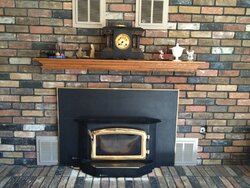Pulled a Regency R14 with a Aug '93 manufacture date from a house to be demolished and installed it into my existing metal lined fireplace.
Why are the two forums that split '93 and older/new stoves? And how can I tell if mine belongs in the newer or older classification?
There's not much of a stove top on this design to get a temp reading. Meaning, it appears that all surfaces I can touch, except for the door and glass, have an air cavity that the fan blows air through. So I don't know how to get a good temp reading of the direct fire heat. Is this important and if so, I'm open to suggestions on how to take a measurement?
I think of more importance to me is the temp of the air being blown out? I have a probe type thermometer (reads to 220) that reads between 180 and 200. Reading through the threads linked in the "Start here" sticky this seems really low. I will search for a higher range thermometer.
I've got a lot to learn on wood, seasoning, etc as I see how this is affecting my burn time, temperature and the flame's enthusiasm. I am still learning how much wood to put in and how much draft to give it.
Thank you in advance for your patience with yet another new guy with the typical newbie questions and I appreciate your advice and/or steering me to a source where I can find the answers.
Thanks,
Leo
Why are the two forums that split '93 and older/new stoves? And how can I tell if mine belongs in the newer or older classification?
There's not much of a stove top on this design to get a temp reading. Meaning, it appears that all surfaces I can touch, except for the door and glass, have an air cavity that the fan blows air through. So I don't know how to get a good temp reading of the direct fire heat. Is this important and if so, I'm open to suggestions on how to take a measurement?
I think of more importance to me is the temp of the air being blown out? I have a probe type thermometer (reads to 220) that reads between 180 and 200. Reading through the threads linked in the "Start here" sticky this seems really low. I will search for a higher range thermometer.
I've got a lot to learn on wood, seasoning, etc as I see how this is affecting my burn time, temperature and the flame's enthusiasm. I am still learning how much wood to put in and how much draft to give it.
Thank you in advance for your patience with yet another new guy with the typical newbie questions and I appreciate your advice and/or steering me to a source where I can find the answers.
Thanks,
Leo



